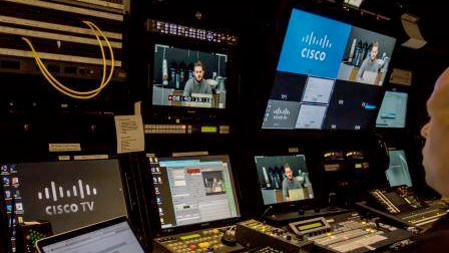Primestream Manages CiscoTV Assets
MIAMI—Known as a pioneering leader in information technology, Cisco Systems is focused on producing a wide-range of corporate content, including live studio shows, promos, and large-scale events for audiences around the world. In order to more effectively communicate both with its clients and with their 73,000 global employees, Cisco has partnered with Primestream to manage and automate its corporate media operations from capture, through to delivery.

“The selection of Primestream was really driven from the need to archive our media, but we didn't have the expertise in developing world-class broadcast media asset management software,” says Brian McCartney, media manager and solutions engineer at Cisco TV. “We wanted something that was going to bring everything together in a single end-to-end solution: something our producers could use to ingest, manage, archive, and automate our media for output to various systems. Primestream can do all of those things.”
CAPTURE
Cisco TV broadcasts live from the Cisco company headquarters in San Jose, Calif., with all of Primestream software running on their own Cisco Unified Computer System (UCS) rack mounted servers. Primestream’s FORKis used to capture live HD signals from the company’s four main studios, their five on campus event centers, and remote events. Remote productions are connected back to San Jose via fiber and are used when hosting large corporate events like Cisco Live, Partner Summit, and the Global Sales Meeting. These events are hosted in large venues like The Mandalay Bay in Las Vegas, Moscone Center in San Francisco, and the San Diego Convention Center.
All video content is recorded in ProRes, and loggers use FORK to tag the content with metadata as it is happening, giving editors with the FORK plugin for Adobe Premiere Pro keywords and markers they can use to search for content. Editing can start while the event is in progress so that as soon as a presentation concludes, content is ready to publish. “This gives us a huge head start on delivering the content” says McCartney.
PRODUCE
CiscoTV’s primary task is to communicate information about Cisco products and processes to the rest of the company. This includes issues dealing with human resources, and training with “virtual teams,” which operate like traditional teams of people but may be spread across different geographic regions, time zones, departments, or organizations.
The professional video industry's #1 source for news, trends and product and tech information. Sign up below.
For example, the virtual team program produces six to eight hours of content per day, four to five days a week, for two to three weeks out of the month during an active season. Their goal is to get product information to the sales engineers so they can efficiently support their clients. “Our programming can be as basic as a webinar or as intricate as network talk show,” explains McCartney. “That’s where Primestream comes in.”
MANAGE
Cisco TV uses FORK to automate its asset management system. “We’re organizing and centralizing the production workflow and tracking the media assets, but we’re also looking to make those assets available for search, review and repurposing,” McCartney said.
Once the content is ingested, automation takes over. The file is encoded and delivered to the Primestream Xchange server; automation then notifies the producer that content is ready to view, download, or mark up with metadata. Any changes made remotely to the proxy content are automatically synced back to the database. “Primestream allows the producers to get into the content and do the things that they need to without any intervention or assistance from anybody on our staff,” said McCartney.
CiscoTV also needed to consolidate 12 years of legacy content, which had previously been archived across multiple formats on tape and on isolated drives. FORK was used to migrate their files to their NetApp SAN, transcode them to ProRes, and to organize the data into “smart folders” where any metadata field is dynamically transformed into properties that can be used to filter, sort, and track content. FORK also created a proxy file viewable in an OS-independent environment.
“Being able to archive our content, get it off the various storage silos, and find it was huge for us,” said McCartney. “The shared storage is the key to our entire system, but FORK is our key to the storage.”
DELIVER
Cisco TV uses FORK Live Assist to play bumpers, trailers, and countdowns into their live broadcasts. FORK is also used to broadcast content to its internal and external network over IP using online webcasting portals like Cisco WebEX. Additionally, Cisco can trigger a FORK automation script that will transcode the native ProRes files into platform-specific codecs with relevant metadata and markers for online publishing to the various portals.
“We’re changing the way we do things for the better at Cisco TV,” adds McCartney. The difference that Primestream makes is in their support and willingness to help us find quick and efficient solutions. We know they have our best interests at heart.”
Robert Lisman is the director of marketing for Primestream.
